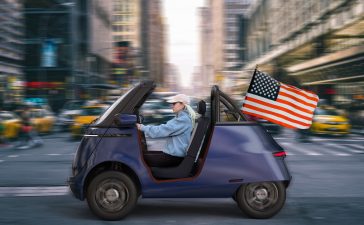Mike Rockwell, Apple vice president for the technology development group, says that from the first second of wearing Apple Vision Pro the experience is designed to be “special.”
Most of the fortunate few who spent time using Apple Vision Pro admit to being stunned by what Apple’s built. But where will it be in two years’ time? “Who is it for?” and “Where’s the killer app?” may be among the questions people ask today, but perhaps the answers are easier to see if we zoom out to zoom in.
What’s next? We’re being told by the man who seems to have a spooky scrying orb inside every Apple boardroom that Apple’s future road map includes a lower-cost system in 2025 along with a product that’s more like normal sunglasses. The latter probably relies on technologies that haven’t been invented yet, so we’ll focus on the headset.
Apple Silicon is essential to Apple’s Vision vision
Apple Silicon is the real star of Cupertino’s show at the moment. It is enabling the company to dream of product designs that just weren’t possible before. The company’s silicon development team seems to be churning out new innovations as swiftly as you can say M3, R1, or 5G.
With so much impact across the company, don’t be surprised if Johny Srouji, Apple’s senior vice president of hardware Ttchnologies, doesn’t appear at every launch. He’s got a lot going on.
One thing he and his teams will be working on is the transition to 3-nanometer chips in iPhones, Macs, and everything else. After a series of challenges, TSMC is expected to begin producing up to 100,000 3nm wafers by the end of the year, with most of this destined to become A17 Bionic chips inside iPhone 15 Pro and Pro Max devices. Meanwhile, Apple’s M2 Ultra chip is almost as fast as AMD and Intel’s fastest processors, which suggests it won’t be long until Apple leads that race.
They’ve got the power…to cut the power
Once the 3nm architecture is inside iPhones, Apple watchers broadly expect it to be rolled out to Macs and iPads, which will be built on the same process architecture. That shift to 3nm should give Apple an even bigger story to tell around performance per watt within its machines. More performance per watt could make for more powerful Macs and longer battery life. It could also yield smaller batteries to enable the company to make smaller and thinner systems.
These processors also sit inside Vision Pro. This means that by the time Apple switches on Vision Pro 2, it will be able to improve system performance while shrinking the battery pack and extending use per charge. No doubt you’ll be able to buy spare and larger battery packs for Vision Pro 1 when it ships, “early next year.” It’s also true that by 2025, M2 processors should have become cheaper to make and to recycle.
Lenticular displays for the people
There has been speculation Apple plans to design its own microLED displays for use in its devices. These may appear first in the Apple Watch, so it feels reasonable to think they might eventually also appear in a Vision device. If so, then it feels logical to think one of the advantages Apple might gain by using its own microLED designs could be a reduction in production costs.
Given the huge importance these displays have to v.1 of the product, any reduction in cost could be reflected in the price of Apple Vision Pro 2.
That’s just one aspect of the technological design that’s gone into these systems, but you can be certain Apple will look to every detail as it moves to make these systems more accessible to the mass market. Owning the inherent tech gives Apple a lot more price flexibility.
What is the killer app?
The “killer app” question is interesting. It’s one that is possibly misplaced. That’s because the killer app with Apple Vision Pro is the platform itself. It’s a platform that makes it possible to create applications and services that could not exist before.
The ability to do that is in itself a killer app. Just in terms of productivity, the interactive environment enables developers to imagine how to visually embody research within spatial experiences. As applications designed to exploit this infinite canvas appear, we’ll see new ways of thinking and linking ideas arrive. When have spatial thinkers ever had tools like these before?
Developers are expected to gain access to some form of development kit starting in July, which means that by the time of Apple’s next big event this fall, it should be able to share a few ideas to show how developers are exploring what’s possible.
(On a more mundane note, I can’t help but imagine Steve Jobs would have pushed someone on Apple’s design team to create a 3D version of Kriegspiel.)
HoloLens for the Apple enterprise
Enterprise developers will already be pondering how to build digital twins in the space – Apple clearly wants them to do so. That’s part of the reason it acquired Mira. It makes sense, after all, to provide an Apple alternative to HoloLens for enterprises, given the extent to which Apple is taking chunks from that market. That’s also why it stressed enterprise uses for the device during last week’s launch event.
Ideas are like confetti, of course. Making ideas that succeed takes refinement and commitment. Some of the first ideas will fail, others may not yet be possible. All the same, a rich collection of applications and experiences impossible to imagine two weeks ago is now inevitably going to be made available at the App Store. The central argument here is that enabling those possibilities is a killer app in its own right.
Vision one
Returning to the present, it seems a little easier to answer some of those questions I mentioned earlier. Not only will Apple improve the product it has already announced by the time it ships “early next year,” but it also has a development road map that perhaps points toward lower cost models in future.
By the time 2025 rolls around, enough people will have spent enough time working within these environments that the next generation of the device will meet an audience of consumers eager to engage with the new tools they’ve been reading about. After all, if the Mac was a bicycle for the mind, Vision may turn out to be the invention of flight.
That’s even before the even bigger idea the tech inevitably leads towards comes into view.
Please follow me on Mastodon, or join me in the AppleHolic’s bar & grill and Apple Discussions groups on MeWe.
Copyright © 2023 IDG Communications, Inc.












